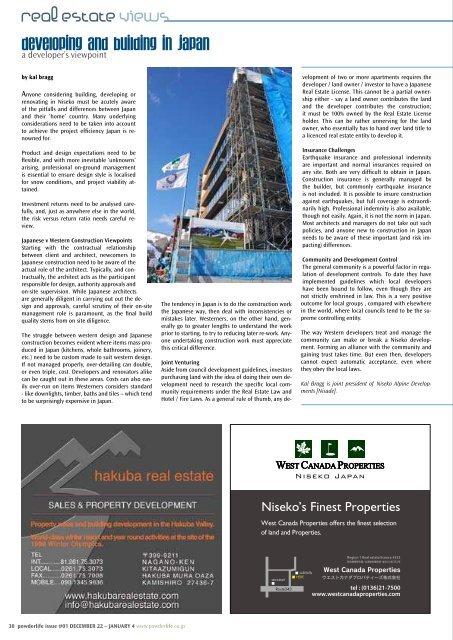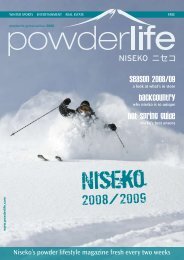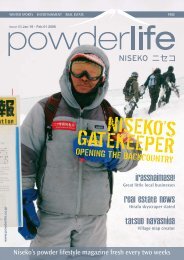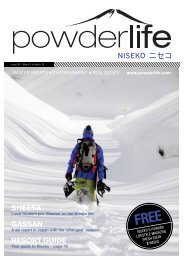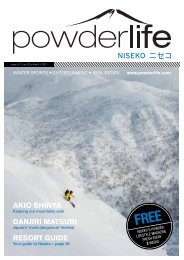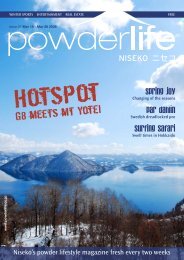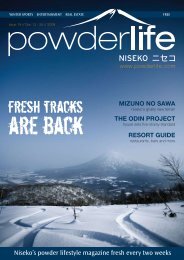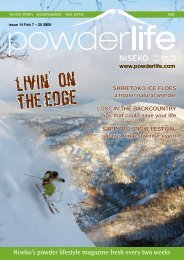Download (15.79 MB) - Powderlife
Download (15.79 MB) - Powderlife
Download (15.79 MB) - Powderlife
You also want an ePaper? Increase the reach of your titles
YUMPU automatically turns print PDFs into web optimized ePapers that Google loves.
eal estate viewsDeveloping and building in Japana developer’s viewpointby kal braggAnyone considering building, developing orrenovating in Niseko must be acutely awareof the pitfalls and differences between Japanand their ‘home’ country. Many underlyingconsiderations need to be taken into accountto achieve the project efficiency Japan is renownedfor.velopment of two or more apartments requires thedeveloper / land owner / investor to have a JapaneseReal Estate License. This cannot be a partial ownershipeither - say a land owner contributes the landand the developer contributes the construction;it must be 100% owned by the Real Estate Licenseholder. This can be rather unnerving for the landowner, who essentially has to hand over land title toa licenced real estate entity to develop it.Product and design expectations need to beflexible, and with more inevitable ‘unknowns’arising, professional on-ground managementis essential to ensure design style is localisedfor snow conditions, and project viability attained.Investment returns need to be analysed carefully,and, just as anywhere else in the world,the risk versus return ratio needs careful review.Japanese v Western Construction ViewpointsStarting with the contractual relationshipbetween client and architect, newcomers toJapanese construction need to be aware of theactual role of the architect. Typically, and contractually,the architect acts as the participantresponsible for design, authority approvals andon-site supervision. While Japanese architectsare generally diligent in carrying out out the designand approvals, careful scrutiny of their on-sitemanagement role is paramount, as the final buildquality stems from on site diligence.The struggle between western design and Japaneseconstruction becomes evident where items mass-producedin Japan (kitchens, whole bathrooms, joinery,etc.) need to be custom made to suit western design.If not managed properly, over-detailing can double,or even triple, cost. Developers and renovators alikecan be caught out in these areas. Costs can also easilyover-run on items Westerners considers standard- like downlights, timber, baths and tiles – which tendto be surprisingly expensive in Japan.The tendency in Japan is to do the construction workthe Japanese way, then deal with inconsistencies ormistakes later. Westerners, on the other hand, generallygo to greater lengths to understand the workprior to starting, to try to reducing later re-work. Anyoneundertaking construction work must appreciatethis critical difference.Joint VenturingAside from council development guidelines, investorspurchasing land with the idea of doing their own developmentneed to research the specific local communityrequirements under the Real Estate Law andHotel / Fire Laws. As a general rule of thumb, any de-Insurance ChallengesEarthquake insurance and professional indemnityare important and normal insurances required onany site. Both are very difficult to obtain in Japan.Construction insurance is generally managed bythe builder, but commonly earthquake insuranceis not included. It is possible to insure constructionagainst earthquakes, but full coverage is extraordinarilyhigh. Professional indemnity is also available,though not easily. Again, it is not the norm in Japan.Most architects and managers do not take out suchpolicies, and anyone new to construction in Japanneeds to be aware of these important (and risk impacting)differences.Community and Development ControlThe general community is a powerful factor in regulationof development controls. To date they haveimplemented guidelines which local developershave been bound to follow, even though they arenot strictly enshrined in law. This is a very positiveoutcome for local groups , compared with elsewherein the world, where local councils tend to be the supremecontrolling entity.The way Western developers treat and manage thecommunity can make or break a Niseko development.Forming an alliance with the community andgaining trust takes time. But even then, developerscannot expect automatic acceptance, even wherethey obey the local laws.Kal Bragg is joint president of Niseko Alpine Developments[Nisade].HOKKAIDO REAL ESTATEExpert property investment and sales advice in NisekoJapan - Asia’s hottest skiing destination.Hokkaido Real Estate is one of Niseko’s market leaders, extremely professional andwith a strong track record. Find out more about the lifestyle or investment opportunities ofour diverse range of properties - please call us on 0136 21 6211 or drop by our office at2F Mountain Side, 190-6 Aza Yamada (50 metres east of Seicomart - towards Kutchan).Contact JASON KING for further informationMobile: 080 5587 5052Email:Web:jason@hokkaidorealestate.comwww.hokkaidorealestate.com30 powderlife issue #01 DECE<strong>MB</strong>ER 22 – JANUARY 4 www.powderlife.co.jp


